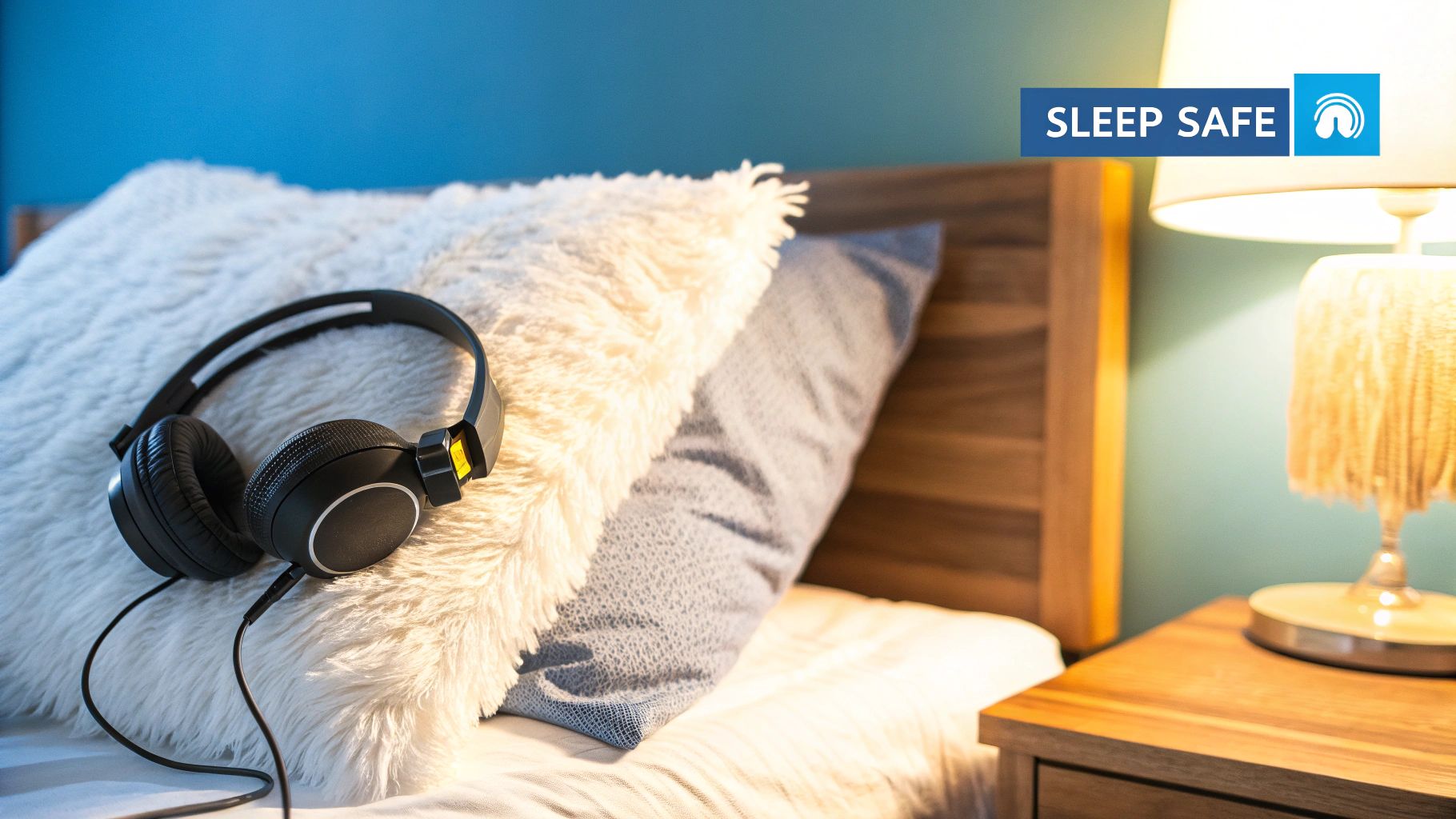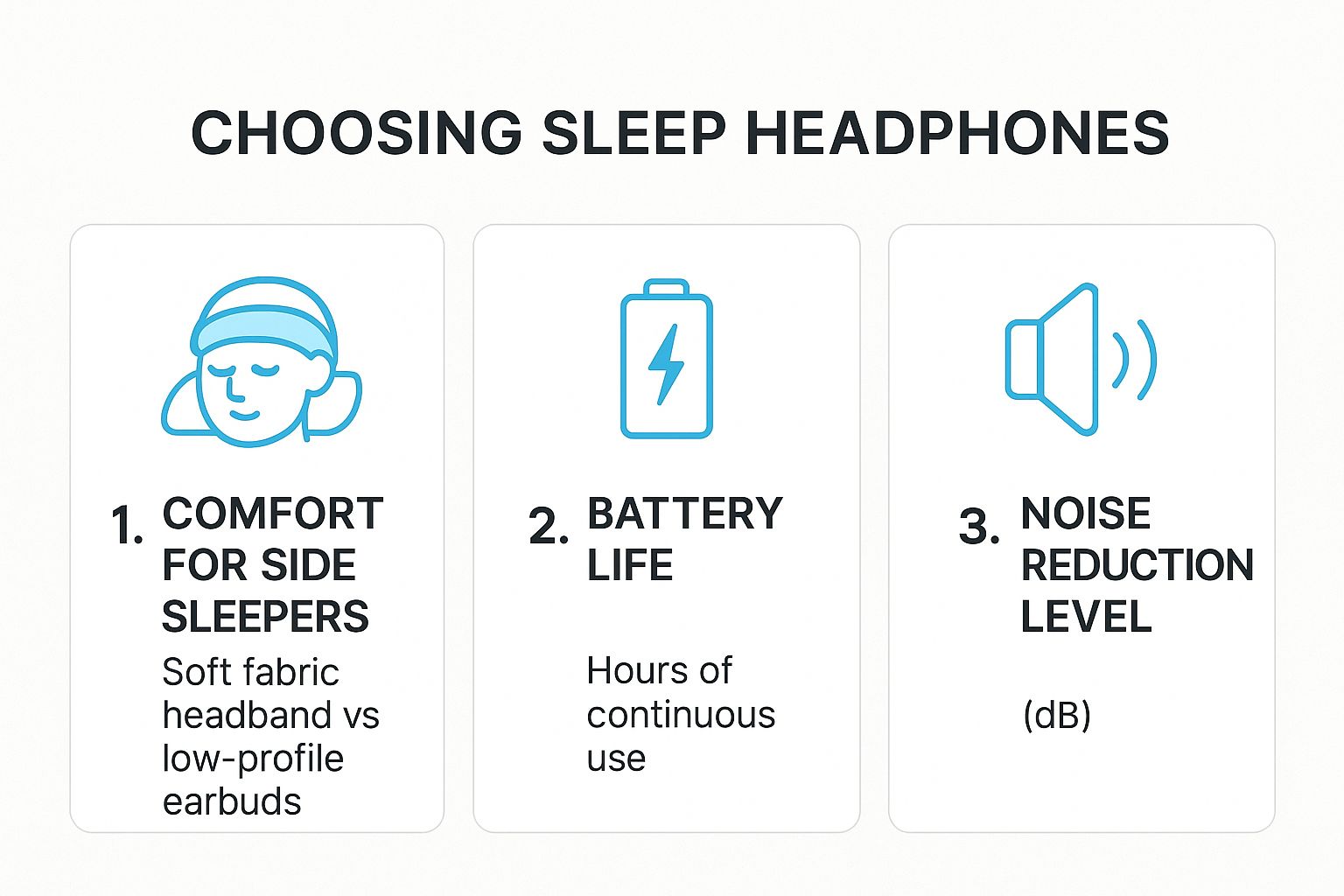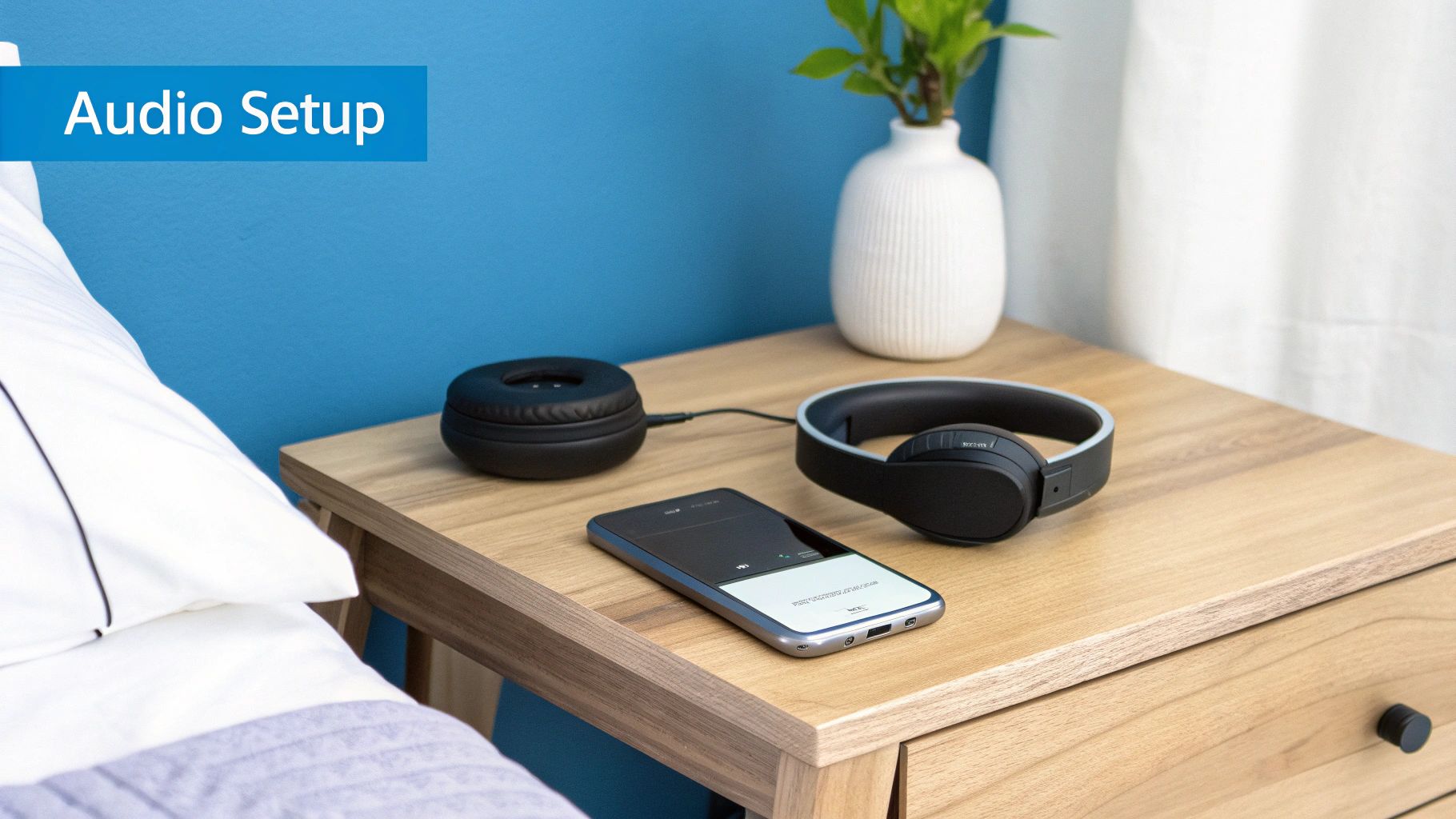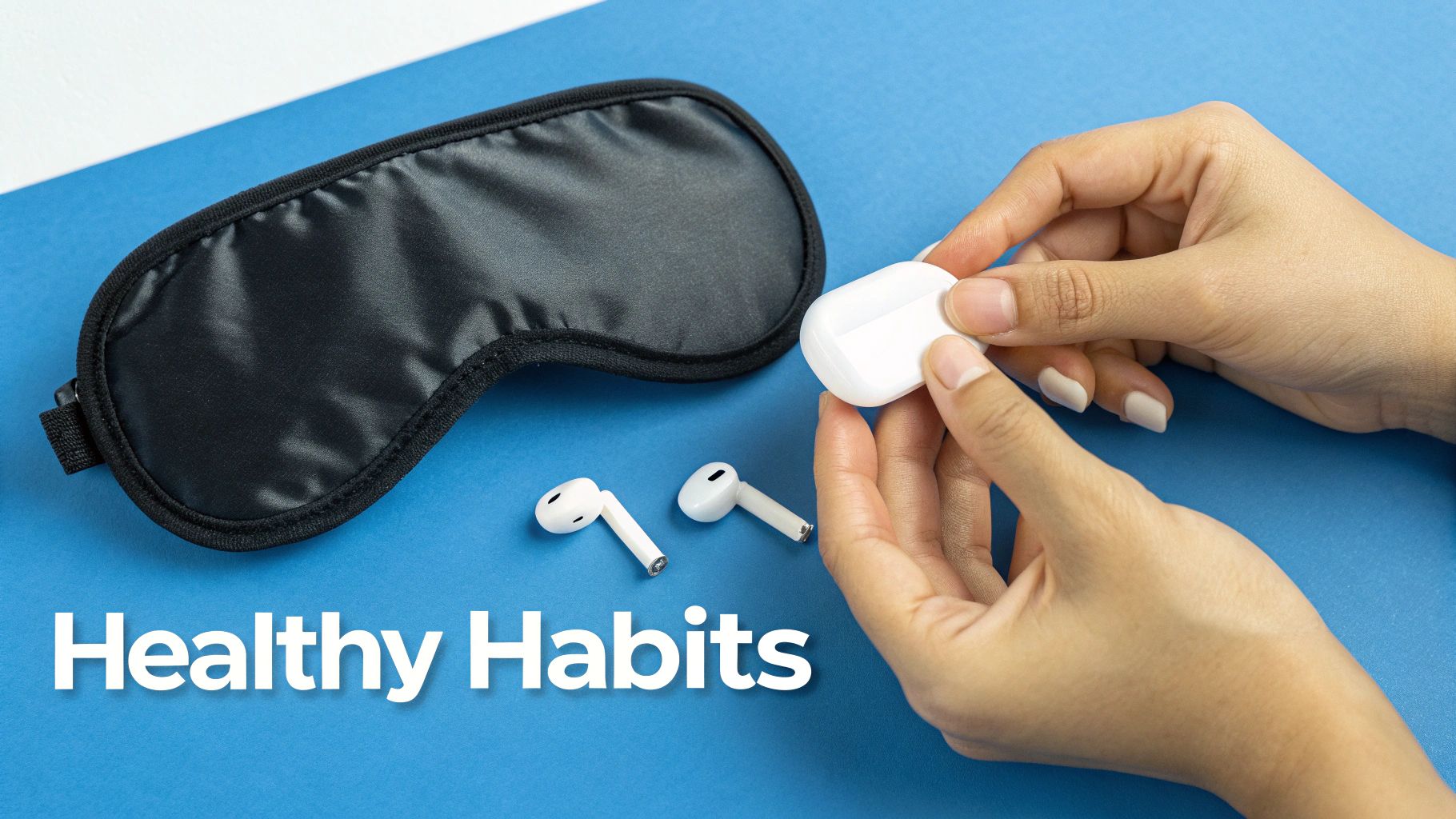Yes, you absolutely can sleep with headphones on. People do it all the time. But the real question we need to ask is whether you should, and if so, how to pull it off safely.
Get it right, and headphones can be a game-changer for your sleep. Get it wrong, and you could be setting yourself up for some long-term issues.
Why Do People Sleep with Headphones, Anyway?

Wearing headphones to bed isn't just some quirky habit. For a lot of folks, it’s a practical solution for getting decent rest in a world that’s anything but quiet. The reasons are as unique as we are, but they usually boil down to a deep need for consistent, restorative sleep.
Think about it. If you live in a bustling city apartment, a little white noise might be the only thing that can drown out the late-night traffic and sirens. Or maybe you're trying to block out a snoring partner to keep the peace (and your sanity).
With the rise of Bluetooth technology, this has become incredibly common. In fact, more than half of U.S. adults now use some kind of background noise to help them sleep, and wireless earbuds are a popular go-to. For many, this simple trick can genuinely improve how well-rested they feel.
Finding the Sweet Spot: The Benefits vs. The Risks
While the immediate perks are pretty obvious, it's crucial to weigh them against the potential downsides. The goal is to find that perfect balance where you're enhancing your sleep without putting your ear health on the line.
Let's break down the pros and cons to give you a clearer picture.
Quick Overview of Sleeping with Headphones
| Potential Benefits | Potential Risks |
|---|---|
| Noise Blocking: Masks disruptive sounds like traffic, neighbors, or a snoring partner, creating a peaceful sleep bubble. | Ear Discomfort & Wax Buildup: Ill-fitting headphones can cause pressure sores, and blocking the ear canal for hours can lead to wax impaction. |
| Anxiety Reduction: Soothing audio, from guided meditations to ambient nature sounds, can calm a racing mind before bed. | Hearing Damage: Prolonged exposure to sound, even at low volumes, can contribute to long-term hearing loss over time. |
| Improved Sleep Quality: A consistent soundscape can help you fall asleep faster and stay asleep longer by minimizing jarring noises. | Reduced Situational Awareness: You might not hear important sounds like a smoke alarm, a baby crying, or an intruder. |
| Masking Tinnitus: For those with ringing in their ears, white noise or other sounds can help make the tinnitus less noticeable. | Infection Risk (Otitis Externa): Earbuds can trap moisture and bacteria in the ear canal, potentially leading to painful outer ear infections. |
As you can see, it's a bit of a trade-off. Using headphones to drift off can be incredibly effective, but leaving them in all night, every night, comes with baggage.
The core principle is simple: Use headphones as a tool to initiate sleep, not as a constant audio stream that lasts all night. Setting a timer is one of the most effective strategies to get the benefits while minimizing the risks.
Ultimately, sleeping with headphones is a personal choice. Now that you understand both sides of the coin, you can make an informed decision that prioritizes your immediate comfort and your long-term well-being. And remember, headphones are just one tool in the toolbox. For a more holistic approach, check out these 12 practical tips for better sleep to truly elevate your rest.
Navigating the Health Risks for Better Sleep
Drifting off to your favorite podcast or playlist can feel like a perfect end to the day. While it’s often a helpful sleep aid, it’s smart to understand what can go wrong when you make it a nightly habit. This isn’t about scaring you off—it’s about building safe, sustainable habits so you can get all the benefits without the drawbacks.
The primary concerns aren't usually dramatic, but they are real and can absolutely build up over time.
The biggest risk? Potential hearing damage. You might think your volume is low, but listening for six to eight hours straight puts continuous strain on the delicate hair cells in your inner ear. Over time, this can lead to noise-induced hearing loss or tinnitus—that persistent ringing sound that nobody wants.
Imagine someone who falls asleep to podcasts every single night. They keep the volume at a seemingly reasonable 50%. After a few months, they start noticing a faint, high-pitched ring in quiet rooms. This is often the first sign that their listening habits are causing permanent, irreversible damage.
The Dangers of Constant Sound Exposure
The real enemy here is prolonged exposure. While a loud concert is an obvious threat, the slow, steady exposure from nightly headphone use is far more subtle.
This is a huge concern for younger listeners. A staggering 17% of teenagers worldwide already show early signs of hearing loss directly linked to unsafe listening habits. Research is clear: sound at 100 decibels (dB) can cause permanent damage in just 15 minutes, yet many headphones can easily blast past 110 dB.
But it's not just about your hearing. Blocking your ear canals for hours on end has other physical consequences.
- Earwax Buildup: Earbuds act like a plug, stopping earwax from naturally working its way out. This can lead to impaction, causing muffled hearing, dizziness, and discomfort.
- Skin Irritation and Necrosis: Ill-fitting or bulky headphones put constant pressure on the delicate skin of your outer ear. In severe cases, this can restrict blood flow and lead to a nasty condition called pressure necrosis, where the skin tissue starts to break down.
- Increased Infection Risk: Your ear canal is warm and dark. Add a headphone that traps moisture, and you’ve created a perfect breeding ground for bacteria. This can lead to painful outer ear infections, also known as swimmer's ear.
The takeaway is simple: volume and duration are the two factors you have to control. Your best bet? Set a sleep timer on your device. Allowing the audio to turn off after 30-60 minutes gives you the benefit of a sleep aid without the risk of all-night sound exposure.
Protecting Your Ears and Overall Health
Adopting a few simple practices can make all the difference. Make a habit of cleaning your earbuds regularly to get rid of bacteria. It's also a great idea to give your ears a break every few nights to let the canals "breathe" and self-clean.
And don’t forget situational awareness. Keep the volume low enough that you could still hear crucial sounds like a smoke alarm or a child calling out.
Beyond the physical concerns, it's vital to understand the bigger picture of sleep's role in our health, including the crucial link between sleep and mental health for teens. Making smart choices about how you use audio at night ensures you’re protecting both your ears and your overall well-being.
How to Choose Headphones Designed for Sleep
Trying to use your everyday gym earbuds for sleep is a bit like trying to run a marathon in flip-flops. Sure, you could try, but you're setting yourself up for a night of frustration, sore ears, and constant fiddling instead of actual rest. When you’re figuring out how to sleep with headphones on, picking the right pair is easily the most important step.
This isn't about chasing high-end audio brands or perfect sound fidelity. It's about zeroing in on three things that actually matter when your head is on a pillow: comfort (especially for side sleepers), solid noise blocking, and a battery that won’t bail on you before your alarm. Those bulky, over-ear headphones that are a lifesaver on a plane? They quickly become a nightmare in bed the second you roll onto your side, creating painful pressure points on your ears.
The Best Headphone Types for Nighttime Use
When it comes to sleep-friendly designs, a few styles consistently come out on top. Each has its own pros and cons, so it's all about matching the design to your specific sleep habits and what you need them for. Let's break down the most popular options.
- Soft Fabric Headbands: These are exactly what they sound like—a comfy, stretchy headband with ultra-thin, flat speakers tucked inside. They’re a go-to for side sleepers because the speakers are cushioned and almost impossible to feel, even with your head pressed into the pillow.
- Low-Profile Silicone Earbuds: Forget the hard plastic buds you wear during the day. These are made from soft, flexible silicone that sits flush inside your ear. They create a gentle seal that blocks out noise passively and won't dig into your ear canal when you lie on your side.
- Bone Conduction Headphones: This is some pretty cool tech. These headphones deliver sound through vibrations on your cheekbones, leaving your ear canal completely open. They are incredibly comfortable since nothing actually goes in or over your ear, but the trade-off is zero noise isolation. That can be a deal-breaker if you're trying to drown out a snoring partner.
To help you sort through the options, I've put together a simple comparison chart that highlights the key features for each type.
Comparing Headphone Types for Sleep
| Headphone Type | Best For | Comfort Level (Side Sleepers) | Noise Blocking |
|---|---|---|---|
| Soft Fabric Headbands | Side sleepers who prioritize comfort over everything | Excellent | Moderate |
| Low-Profile Silicone Buds | Blocking out ambient noise & for a discreet fit | Good to Excellent | Excellent |
| Bone Conduction | Those who hate anything in or on their ears | Excellent | None (by design) |
As you can see, it really comes down to what you need most. If you're a side sleeper who just wants to listen to a podcast without waking up with sore ears, a fabric headband is probably your best bet. If blocking out the neighbor's dog is your top priority, low-profile earbuds are the way to go.

This visual guide confirms that soft headbands often hit the sweet spot for all-around comfort, especially for side sleepers, while the smaller earbuds are champions of noise reduction.
Key Features to Prioritize
Beyond just the basic style, there are a few more details to look into before you buy. Paying attention to these specifics can be the difference between a good night's sleep and another frustrating purchase.
First up, battery life is non-negotiable. You absolutely need a pair that can last at least 8-10 hours on a single charge. There’s nothing worse than being jolted awake at 3 a.m. by a "battery low" announcement.
Next, look at the material and fit. For headbands, find one with breathable, machine-washable fabric to keep things clean and fresh. For earbuds, make sure they come with a few different tip sizes so you can find a secure, yet gentle, fit for your specific ear shape. Our guide on finding comfortable headphones for sleeping goes into much more detail on specific models and materials that get the job done.
The goal is to find headphones so comfortable you completely forget you're wearing them. If you’re constantly shifting them around or you wake up with achy ears, they aren't the right pair for you—no matter what other fancy features they have.
Creating Your Ideal Sleep Audio Setup

Picking the right headphones is a huge piece of the puzzle, but what you listen to—and just as importantly, how you listen—is the other half of the equation for a safe, restful night. The real goal here is to build a soothing audio environment that helps you drift off without accidentally causing harm. It’s all about being deliberate with your sound, volume, and timing.
This whole process starts with choosing the right kind of audio. Not all sounds are created equal when you're trying to sleep. A fascinating podcast or your favorite high-energy playlist can actually kick your brain into high gear, doing the exact opposite of what you want.
Instead, your best bet is to focus on sounds specifically designed for relaxation. Many people have great success with continuous, monotonous audio that can effectively drown out jarring external noises like late-night traffic or a neighbor's TV. Our guide on using white noise headphones for sleeping dives deep into how these sounds create a consistent auditory blanket. Other fantastic options, like binaural beats, use specific frequencies to gently nudge your brainwaves toward a state of rest.
Setting Up Your Device for Safe Listening
Okay, so you've picked out your audio. The next move is to get your device settings in order. This is a critical safety step that so many people skip when they first start sleeping with headphones on. You need to get a handle on two things: volume and duration.
Here are the non-negotiable settings you need to configure:
- Set a Volume Limit: Dive into your phone’s settings (it’s under "Sounds & Haptics" on an iPhone or "Sound & vibration" on an Android) and cap the maximum volume. Think of this as a safety net that prevents any accidental volume spikes from blasting your eardrums while you're asleep.
- Use a Sleep Timer: Please, don't leave audio playing all night. On Spotify, you can just tap the little moon icon to set a timer. For iPhones, you can go into the Clock app’s timer and set the "When Timer Ends" function to "Stop Playing." It’s a simple action that gives your ears a much-needed break.
These two tweaks are absolutely essential for your long-term ear health. They let you get all the benefits of using audio to fall asleep while drastically cutting the risks of all-night exposure.
Think of your sleep audio setup like a bedtime ritual. It should be consistent, calming, and have a clear endpoint. The goal is to use sound as a tool to drift off, not as an eight-hour concert for your eardrums.
Wired vs. Wireless: The Final Piece of the Puzzle
When it comes to the wired vs. wireless debate for sleep, it really boils down to one thing: safety. While some people get worried about Bluetooth radiation, the scientific consensus is that the low-level emissions are perfectly safe. The bigger, more immediate concern with wired headphones is entanglement.
It's shockingly easy for a cord to wrap around your neck as you toss and turn, creating a very real strangulation hazard. For this reason alone, wireless is almost always the safer and more practical choice for sleeping.
Yes, you have to remember to charge them, but that's a tiny trade-off for peace of mind and physical safety. Besides, modern sleep headbands and low-profile earbuds offer excellent battery life, making it a minor inconvenience at worst.
Building Healthy Nightly Headphone Habits

Popping in your headphones and drifting off to sleep sounds simple enough, but making it a sustainable, healthy habit is more than a "set it and forget it" deal. It’s really about creating a small routine that protects your ears and keeps your gear in good shape.
Think of it just like any other part of your sleep hygiene. You wouldn't neglect making your room dark and cool, right? The same principle applies here. A little maintenance for your audio setup goes a long way in preventing minor annoyances from turning into major problems.
One of the most crucial—and often overlooked—steps is regular cleaning. Night after night, your earbuds can become a breeding ground for bacteria and trap earwax, which can lead to some pretty painful infections or blockages. You don't need a complicated cleaning kit; a simple wipe-down with a soft cloth and a touch of 70% isopropyl alcohol once a week usually does the trick.
Creating a Routine for Ear Health
Beyond keeping your gear sanitary, it’s vital to give your ears a break. I know it can be tempting to use them every single night, especially if you've come to rely on them to fall asleep.
But try to designate one or two nights a week as "headphone-free." This gives your ear canals a chance to breathe, air out, and naturally clear out any wax buildup without being obstructed.
Here are a few more habits to fold into your nightly routine:
- Practice Situational Awareness: This one is non-negotiable. Your volume should always be low enough that you could still hear a smoke alarm, a baby crying, or any other emergency sound. Safety has to be the top priority.
- Alternate Your Content: Listening to high-energy podcasts or intense music can actually interfere with your sleep cycles. To build a healthier habit, it's worth exploring what not to listen to before bed and sticking to calming sounds like white noise or ambient music.
- Listen to Your Body: If you ever wake up with sore ears or any kind of discomfort, take a few nights off. It’s a clear signal from your body that your ears either need a rest or that your headphones just aren't the right fit.
Remember, the goal is to use headphones as a sleep aid, not a sleep crutch. Consistency in these small maintenance habits will ensure you can safely enjoy the benefits for years to come.
Hearing damage from headphone use is a growing concern. One study found that a startling 74.1% of leisure headphone users showed early signs of hearing impairment that often go unnoticed. This kind of "subclinical" damage can worsen over time, which makes these simple preventative habits absolutely essential.
Still Have Questions About Sleeping with Headphones?
Even with the basics covered, you might be wrestling with a few specific concerns. The little details really do matter when you're deciding whether to make headphones a part of your nightly routine. Let's dig into some of the most common questions people ask.
Can Sleeping with Headphones Cause Tinnitus?
Yes, this is a real risk and something to take seriously. Tinnitus, that frustrating, persistent ringing in your ears, is often the result of damage to the tiny, delicate hair cells inside your inner ear. Blasting audio for hours on end overnight—even at a volume that seems reasonable—is a perfect recipe for this kind of slow-burn damage.
The good news is, you can drastically lower your risk. It’s a two-part strategy. First, always, always use the lowest possible volume that still lets you hear your audio. Second, get into the habit of setting a sleep timer. This shuts everything off after you’ve drifted off, giving your ears a long and crucial period of silence to recover.
The real danger isn't just a sudden blast of loud noise; it's the duration of exposure. Giving your ears several hours of total silence each night is just as important as keeping the decibels down.
Are Wireless or Wired Headphones Better for Sleeping?
For almost everyone, wireless headphones are the clear winner for safety and comfort when you're sleeping. Models like soft sleep headbands or very low-profile earbuds completely remove the risk of getting tangled up in a cord. It might sound like a freak accident, but a cord wrapping around your neck is a genuine, albeit rare, safety hazard you don't need to worry about.
Sure, wired headphones have one thing going for them: they never need to be charged, so you can forget about battery anxiety. But the peace of mind and freedom that come with going wireless generally make them the smarter choice for nighttime use. Having to charge them is a small price to pay for safety.
What Is the Best Audio Content for Falling Asleep?
This is incredibly personal, but some types of audio are definitely better than others at lulling your brain to sleep. The trick is to pick something that's calming and monotonous—you want to avoid anything that keeps your mind alert and engaged.
Here are a few proven options to try out:
- White, Pink, or Brown Noise: These are fantastic for masking distracting sounds from outside, creating a steady, predictable soundscape for your brain to relax into.
- Guided Meditations: Specifically designed sleep meditations can be a game-changer for calming a racing mind and signaling to your body that it's time to rest.
- Gentle Nature Sounds: The sound of consistent, gentle rain or ocean waves can be incredibly soothing without being distracting.
What should you avoid? Anything that tells a story or has a lot of variation. That means skipping the engaging podcasts, complex audiobooks, and music with sudden changes in volume or tempo. The goal is to find audio your brain can simply tune out as you drift off.
How Do I Clean My Headphones to Prevent Infections?
This is non-negotiable. Regular cleaning prevents the buildup of earwax, oils, and bacteria that can lead to nasty skin irritation or even painful ear infections. It’s a simple habit that makes a huge difference.
If you use silicone earbuds, just wipe the tips gently with a soft cloth lightly dampened with 70% isopropyl alcohol. Let them air dry completely before you use them again. For a fabric sleep headband, pop out the electronic parts and wash the band itself according to the manufacturer's directions. A quick clean once a week is all it takes to keep your gear hygienic and your ears healthy.
At DubsLabs, we're obsessed with helping you get the kind of deep, restorative sleep you deserve. Our Bedphones are engineered for ultimate comfort, letting you drift off peacefully without any bulky, painful hardware getting in the way. Discover how our sleep solutions can transform your nights.











































